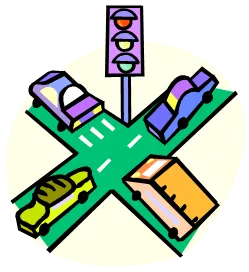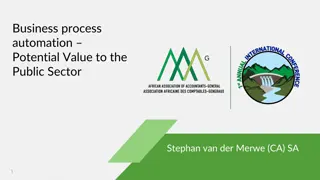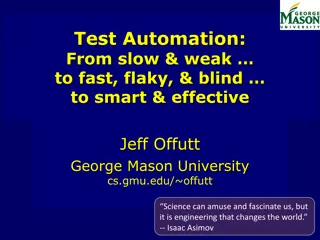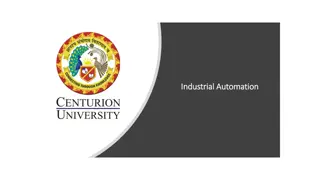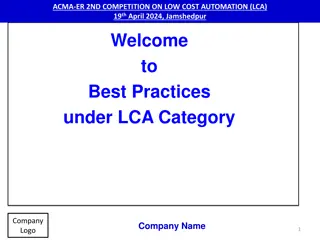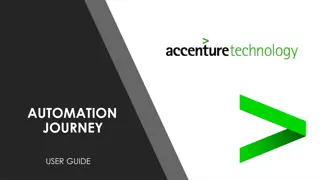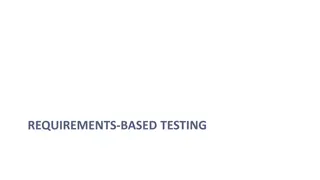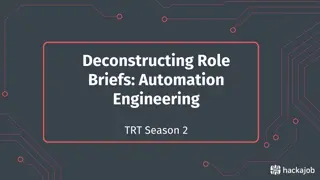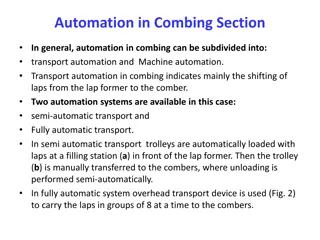Evolution of Test Automation and Modern Testing Practices
Explore the evolution of test automation and modern testing practices, from the manual testing era to the reasons for automating testing. Learn about the challenges, achievements, and takeaways in the field of test automation. Discover the importance of software testing in ensuring high-quality products and reducing risks for users.
Download Presentation

Please find below an Image/Link to download the presentation.
The content on the website is provided AS IS for your information and personal use only. It may not be sold, licensed, or shared on other websites without obtaining consent from the author. Download presentation by click this link. If you encounter any issues during the download, it is possible that the publisher has removed the file from their server.
E N D
Presentation Transcript
Test Automation and Modern Testing Practices Jeff Offutt George Mason University cs.gmu.edu/~offutt Science can amuse and fascinate us, but it is engineering that changes the world. -- Isaac Asimov
Software is a skin that surrounds our civilization Quote due to Dr. Mark Harman why test? test automation TA achievements major challenges & open problems takeaways of 38 2
Why do we test? Test process maturity levels Testing is a mental discipline that helps us develop high quality software Level 4 The purpose of testing is to reduce the risk of using the software Level 3 The purpose of testing is to show that the software doesn t work Level 2 The purpose of testing is to show correctness Level 1 There s no difference between testing and debugging Level 0 why test? test automation TA achievements major challenges & open problems takeaways of 38 3
Put simply A software tester tries to spot software failures before they are inflicted on users why test? test automation TA achievements major challenges & open problems takeaways of 38 4
Why automate testing? The usual reasons for automation reduce cost and increase value (increase RoI) Reduce repetitive work Increase predictability Increase execution speed Better software reduces support costs why test? test automation TA achievements major challenges & open problems takeaways of 38 5
Pre-history: Manual testing Before automation, testers entered inputs by hand Inputs often arbitrary Entirely system testing Slow Repeatability problems Testers made errors o Mis-entered values o Missed erroneous results Common among CS students why test? test automation TA achievements major challenges & open problems takeaways of 38 6
Early (partial) automation Tests designed by hand Tests were sequences of actions and inputs Sometimes executed all or partially by software Results checked by human Entirely system testing Somewhat repeatable Fewer errors Slow & expensive why test? test automation TA achievements major challenges & open problems takeaways of 38 7
Test automation in the 1990s System testing test automation tools Often project- or company-specific Test values usually designed by hand Result checking usually by hand Capture-replay tools for GUIs Captured inputs and result screens from manual tests Replayed tests when software changed Early unit-level test frameworks Not accessible to non-programmers Most were research demonstration tools Automatic checking of outputs via assertions JUnit integrated the best ideas and simplified why test? test automation TA achievements major challenges & open problems takeaways of 38 8
Then this happened 60 50 40 Fault origin (%) 30 Fault detection (%) 20 10 Unit cost (X) 0 Software Engineering Institute; Carnegie Mellon University; Handbook CMU/SEI-96-HB-002 why test? test automation TA achievements major challenges & open problems takeaways of 38 9
Evidence of RoI for unit testing 60 Assume $1000 unit cost per fault, 100 faults 50 40 Fault origin (%) 30 Fault detection (%) 20 10 Unit cost (X) 0 Software Engineering Institute; Carnegie Mellon University; Handbook CMU/SEI-96-HB-002 why test? test automation TA achievements major challenges & open problems takeaways of 38 10
Unit testing and automation Unit tests are easier to automate Thus more automation More modularity Less re-design Faster to produce Re-verification supports evolution Cheaper Less repetitive work Better software reduces support costs More predictable why test? test automation TA achievements major challenges & open problems takeaways of 38 11
Example automated unit test @Test Expected output (expected = ClassCastException.class) public void testMutuallyIncomparable () { List list = new ArrayList(); Setup (prefix) values list.add("cat"); list.add("dog"); Test case values list.add(1); Postfix values Object obj = Min.min(list); } abstract concrete why test? test automation TA achievements major challenges & open problems takeaways of 38 12
Categories of TA activities Test automation Execution Generation Management how what new test change test delete test test oracle prefix postfix values test values human-based human scripts prefix & postfix criteria-based C/R (GUIs) assembled pieces script languages frameworks (JUnit) test oracle continuous integration (DevOps) why test? test automation TA achievements major challenges & open problems takeaways of 38 13
Elements of test automation (generation) (1) model-based testing (tests from abstract models) why test? test automation TA achievements major challenges & open problems takeaways of 38 14
Model-based testing (abstract test design) model / structure test requirements abstract test values Abstract level (model) Concrete level (implementation) software artifact input values pass / fail test results test scripts test cases why test? test automation TA achievements major challenges & open problems takeaways of 38 15
Software models Models represent software at an abstract level formal models have formal semantics and can often be executed informal models omit details and thus cannot be executed Uses of models design & specification documentation maintenance and evolution testing Types of models 1. graphs 2. logic expressions 3. sets 4. formal syntax (source code, BNF, XML, etc) why test? test automation TA achievements major challenges & open problems takeaways of 38 16
Software to models code CFGs statecharts designs Abstract graph requirements use cases 1 FSMs, PNs formal models 3 2 4 code decisions statecharts decisions designs Logic expression (A & B ) | (C & D) use case decisions requirements formal models FSMs, PNs, SMV why test? test automation TA achievements major challenges & open problems takeaways of 38 17
Model-based testing process Model Criterion Test requirements Abstract tests Extra information Concrete tests Test execution Test reports why test? test automation TA achievements major challenges & open problems takeaways of 38 18
Elements of test automation (generation) (2) mapping problem (abstract test to concrete test) why test? test automation TA achievements major challenges & open problems takeaways of 38 19
Mapping examplevending machine Abstract test: [ 1, 3, 4, 1, 2, 4 ] Refined abstract test: Concrete test (mapping): 1. 2. 3. 4. 5. Testers build abstract tests by hand But each transition maps to specific concrete actions Automate by assembling concrete test components Coin Coin 1 2 AddChoc, Coin, GetChoc, Coin, AddChoc GetChoc AddChoc AddChoc c= m&ms ; addChocolate(c); v= $1 ; addCoin(v); chooseChocolate(c); dispense(); v= $1 ; addCoin(v); c= m&ms ; addChocolate(c); Coin 3 4 GetChoc AddChoc or Coin AddChoc why test? test automation TA achievements major challenges & open problems takeaways of 38 20
Assembling test components Test components Test 1 Test 2 C1 C1 C1 C2 C2 C3 C3 Test 3 C4 C4 C4 C5 C5 C5 C6 C6 C7 C7 why test? test automation TA achievements major challenges & open problems takeaways of 38 21
Elements of test automation (generation) (3) test oracles (expected result from a test) why test? test automation TA achievements major challenges & open problems takeaways of 38 22
A test oracle knows correct behavior of the software An automated test must include expected output for that test why test? test automation TA achievements major challenges & open problems takeaways of 38 23
RIPR model Outputs Test final program state Reaches Reachability Observed final output state Infection Fault Incorrect final output Propagation Infects Propagates Reveals Revealability Error program state Test oracles why test? test automation TA achievements major challenges & open problems takeaways of 38 24
What makes a good test oracle? Do test oracles need to observe the entire output space? Arbitrarily large Do test oracles need to observe intermediate states? Do test oracles always return the same answer? How do we automate test oracles when we do not know the correct output? How do we model test oracles? Lots of partial answers to these questions Researchers are still hard at work Here are a few answers why test? test automation TA achievements major challenges & open problems takeaways of 38 25
Good test oracles are consistent Sometimes tests behave differently on different runs test A run 1 test A run 2 test A run 3 Google says 16% of their tests are flaky What makes a test flaky? Concurrency Asynchronous behavior Random inputs Resource leaks Test order dependency Library class assumptions Relying on external systems why test? test automation TA achievements major challenges & open problems takeaways of 38 26
Good test oracles look Smoke (crash) tests miss about two-thirds of the failures Why waste a good test? Tests are expensive to design, to implement, and to run @Test (expected = NullPointerException.class) public void addOneValue() { list.addFront( cat ); Object obj = list.getFirst(); } ??? Should check: [ cat ] why test? test automation TA achievements major challenges & open problems takeaways of 38 27
Good test oracles can see A blind test does not check the portion of the output that is incorrect @Test public void testTwoValues() { list.addFront( dog ); list.addFront( cat ); Object obj = list.getFirst(); assertTrue( Two values , obj.equals( cat )); } Passes: [ cat ] [ cat, cat ] [ cat, null ] Should check: [ cat, dog ] Up to 40% of industry automated tests are blind why test? test automation TA achievements major challenges & open problems takeaways of 38 28
Blind tests in the RIPR model Outputs Test final program state Incorrect final output Reaches Reachability Infection Fault Observed final output state Propagation Infects Propagates Does NOT reveal Revealability Error program state Test oracles why test? test automation TA achievements major challenges & open problems takeaways of 38 29
Categories of TA activities Test automation Execution Generation Management how what new test change test delete test test oracle values prefix postfix test values human-based human scripts prefix & postfix criteria-based C/R (GUIs) assembled pieces script languages used in industry frameworks (JUnit) test oracle active research continuous integration (DevOps) both why test? test automation TA achievements major challenges & open problems takeaways of 38 30
Four challenges and problems in test automation why test? test automation TA achievements major challenges & open problems takeaways of 38 31
TA challenges and problems (1) Education and scalability Most software developers learned very little about testing in their education Testing courses are rare at universities A two-week overview in a general software engineering course is not enough Google sends new developers to a six-week testing boot camp Why do students major in Computer Science to become Software Engineers? why test? test automation TA achievements major challenges & open problems takeaways of 38 32
TA challenges and problems (2) Testing mobile apps Many details are very different Test automation tools (execution) are very slow Most inputs are through the screen with funny gestures and auto-fills Challenging to automate Every mobile device has its own ecosystem How to model these ecological communities? How to test entanglements with other apps? What does a test oracle look like in a mobile app? why test? test automation TA achievements major challenges & open problems takeaways of 38 33
TA challenges and problems (3) Test oracles We need to automate generation TOs are still usually created by hand Old, current, and new approaches: Formal specifications lots of research, but limited use Aggregating unit-level TOs into system-level TOs Impact analysis to identify which parts of output state to check Screen capturing approaches Machine learning to guess expected results? Leverage TDD tests to create expected results for similar tests? why test? test automation TA achievements major challenges & open problems takeaways of 38 34
TA challenges and problems (4) Non-determinant software We cannot know the result a priori Examples: Games, loan eligibility, scientific modeling, non-deterministic, AI & ML, How to build automated tests? Inputs are often very complicated Test oracles JUnit assertions are not enough Instead of correct behavior, we need acceptable behavior why test? test automation TA achievements major challenges & open problems takeaways of 38 35
Takeaways (1) Test automation has had enormous impact test scripts test oracle continuous integration JUnit agile & TDD capture replay test suite management model- based testing DevOps why test? test automation TA achievements major challenges & open problems takeaways of 38 36
Takeaways (2) Good models empower test automation test model / structure requirements Execution Generation Management Abstract level how what new test change test delete test Concrete level software artifact values test oracle prefix postfix input values test values human-based human scripts pass / fail test results test scripts test cases prefix & postfix criteria-based C/R (GUIs) script languages assembled pieces frameworks (JUnit) test oracle continuous integration Outputs Test final program state Reaches Observed final output state Incorrect final state 1 3 Fault 2 4 Infects Error program state (A & B ) | (C & D) Propagates Reveals Test oracles why test? test automation TA achievements major challenges & open problems takeaways of 38 37
Takeaways (3) We have barely started! Every advance reveals two more tasks we can automate Computer science amuses and fascinates us, but automation changes the world. (paraphrasing Isaac Asimov) Jeff Offutt cs.gmu.edu/~offutt why test? test automation TA achievements major challenges & open problems takeaways of 38 38

 undefined
undefined




















